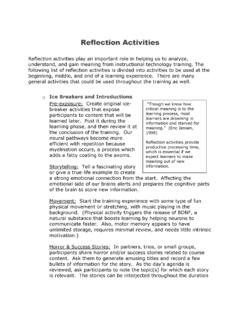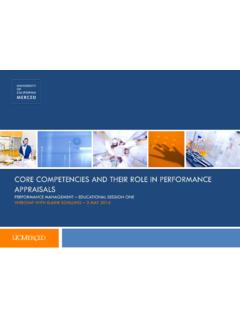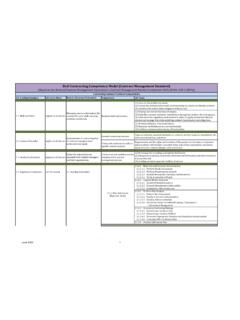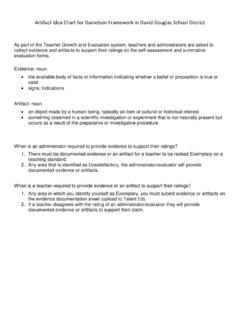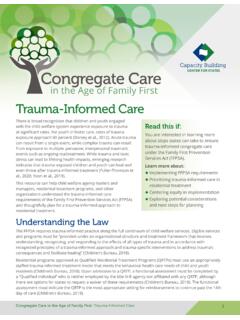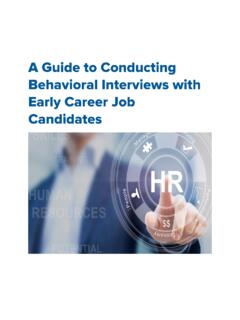Transcription of ATLAS-Looking at Data Protocol - The To&Through Project
1 218218 ATLAS-Looking at Data Protocol A Protocol to guide conversation when data is the focal point. The structured approach of a Protocol , with clear norms and expectations for conversation, creates a safe space for all participants. This Protocol supports equity of voice and allows all members to describe the data, make inferences, and share implications for future Data-Driven Conversations TOOL SET B218 IMPLEMENTING SCHOOL-BASED TEAMSNCS FRESHMAN ON-TRACK TOOLKITP rotocols are most powerful and effective when used within an ongoing professional learning community and facilitated by a skilled facilitator. To learn more about professional learning communities and seminars for facilitation, please visit the School Reform Initiative website at at DataLearning from Data is a tool to guide groups of teachers discovering what students, educators, and the public understand and how they are thinking.
2 The tool, developed by Eric Buchovecky, is based in part on the work of the Leadership for Urban Mathematics Project and the Assessment Communities of Teachers Project . The tool also draws on the work of Steve Seidel and Evangeline Harris-Stefanakis of Project Zero at Harvard University. Revised November 2000 by Gene Thompson-Grove. Revised August 2004 for Looking at Data by Dianne Started The facilitator reminds the group of the norms. The educator providing the data set gives a very brief statement of the data and avoids explainingwhat she/he concludes about the data if the data belongs to the group rather than the : Each of the next 4 steps should be about 10 minutes in length. It is sometimes helpful for thefacilitator to take the Data (10 minutes) The facilitator asks: What do you see?
3 During this period the group gathers as much information as possible from the data. Group members describe what they see in data, avoiding judgments about quality or is helpful to identify where the observation is being made , On page one in the secondcolumn, third If judgments or interpretations do arise, the facilitator should ask the person to describe the evidenceon which they are based. It may be useful to list the group s observations on chart paper. If interpretations come up, they canbe listed in another column for later discussion during Step the Data (10 minutes) The facilitator asks: What does the data suggest? Followed by What are the assumptions wemake about students and their learning? During this period, the group tries to make sense of what the data says and why.
4 The group should tryto find as many different interpretations as possible and evaluate them against the kind and quality ofevidence. From the evidence gathered in the preceding section, try to infer: what is being worked on and why? Think broadly and creatively. Assume that the data, no matter how confusing, makes sense to somepeople; your job is to see what they may see. As you listen to each other s interpretations, ask questions that help you better understand eachother s are most powerful and effective when used within an ongoing professional learning community and facilitated by a skilled facilitator. To learn more about professional learning communities and seminars for facilitation, please visit the School Reform Initiative website at Implications for Classroom Practice (10 minutes) The facilitator asks: What are the implications of this work for teaching and assessment?
5 Thisquestion may be modified, depending on the data. Based on the group s observations and interpretations, discuss any implications this work might havefor teaching and assessment in the classroom. In particular, consider the following questions: What steps could be taken next? What strategies might be most effective? What else would you like to see happen? What kinds of assignments or assessments could providethis information? What does this conversation make you think about in terms of your own practice? About teachingand learning in general? What are the implications for equity?5. Reflecting on the ATLAS-Looking at Data (10 minutes)Presenter Reflection: What did you learn from listening to your colleagues that was interesting or surprising? What new perspectives did your colleagues provide?
6 How can you make use of your colleagues perspectives?Group Reflection: What questions about teaching and assessment did looking at the data raise for you? Did questions of equity arise? How can you pursue these questions further? Are there things you would like to try in your classroom as a result of looking at this data? the Process (5 minutes) How well did the process work? What about the process helped you to see and learn interesting or surprising things? What could be improved?221 ATLAS - Looking At Data ProtocolInstructionsThis is an example of the questions that would stem from each of the ATLAS Protocol steps. It can also serve as a template for note-taking. For each of the four phases of the ATLAS Protocol , jot down additional questions that can be raised to elicit deeper analysis and reflection from Data-Driven Conversations TOOL SET BWhat do we see in terms of: Performance in corecourses vs electives?
7 Historical performanceover time in courses?(if provided in graph) Entire grade level vsspecial populations? (ifstudent lists are provided) Boys performance? Girls performance? The proportion of stu-dents with B s or better vsthose with D s and F s? Proximity to our annual/quarterly On-Track bench-mark? (if point-in-timeOn-Track percentage isshared) Change in performanceof students targeted forintervention? Number of off-trackstudents who haveaverages within the40 59% range?What does the data suggest about: Academic rigor of thecourses? Student attendancepatterns? The effectiveness ofour Tier 2 interventionon targeted students? Execution of themodifications andaccommodations instudent IEPs? Execution of learningplans for our ELLs? Our tenacity in regularlyupdating grades? Arethese grades a truereflection of where stu-dents are academically?
8 The quantity and typesof opportunities given forstudents to succeed?What does this mean for our work in terms of: Students who are nearlyoff track? Students who are offtrack? Students who are failingmore than 3 classes? Our needs as teachersto successfully meetthe directives in studentIEPs and/or ELL learningplans? Improving student accessto the concepts and skillsin our courses? Adjusting our Tier 2intervention? Ensuring grades areas current as possibleso that our actions areaddressing real-timeneed?From all the implications, what would be the high leverage next steps we can take toward improvement? (Limit the next steps to no more than 3, especially if the whole team is owning them)Adapted from the School Reform Initiative ATLAS (What do we see?)INTERPRETATIONS & WONDERINGS(What does the data suggest?)
9 IMPLICATIONS(What does this mean for our work?)NEXT STEPS(So what are we going to do?) IMPLEMENTING SCHOOL-BASED TEAMSNCS FRESHMAN ON-TRACK TOOLKIT

